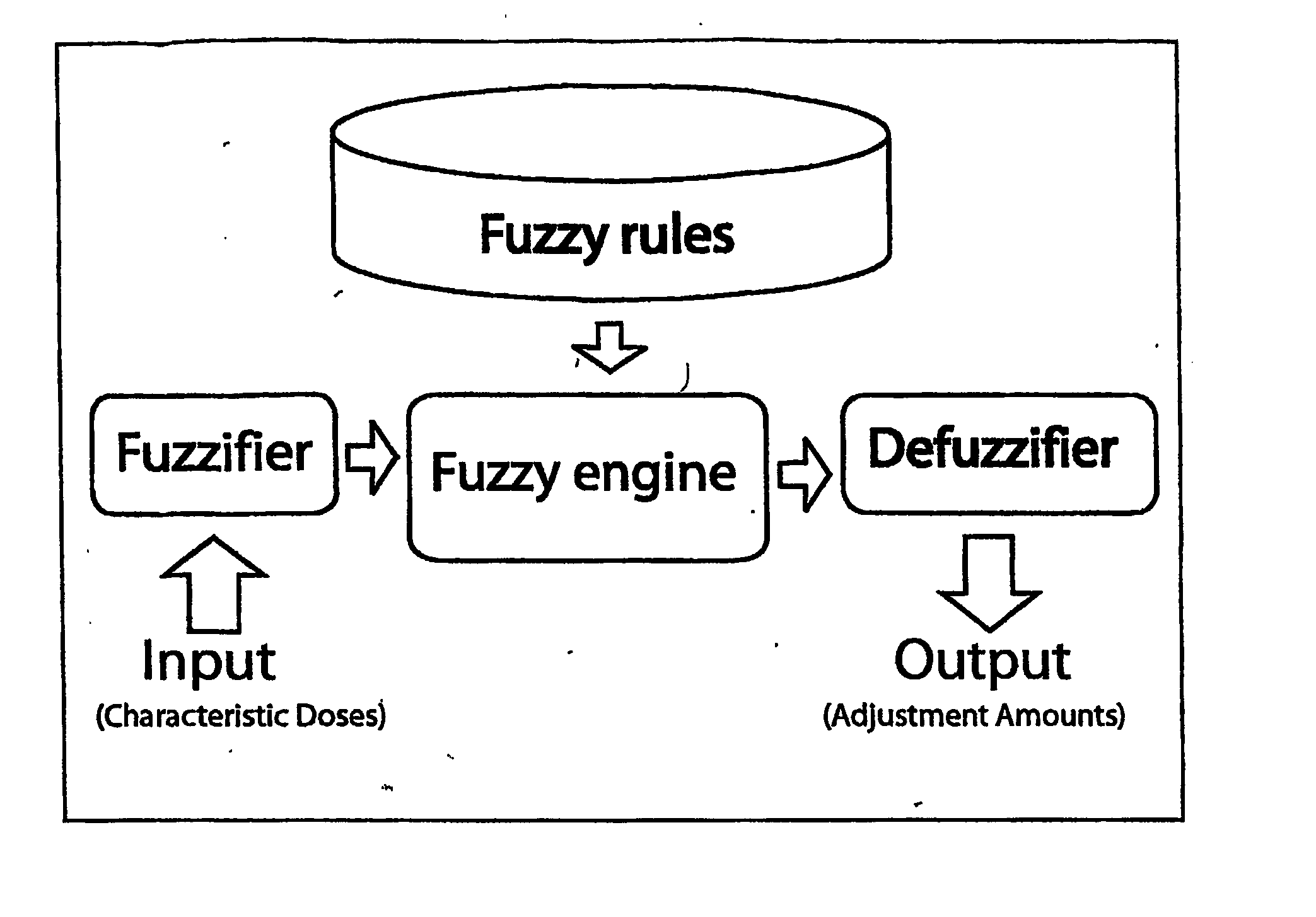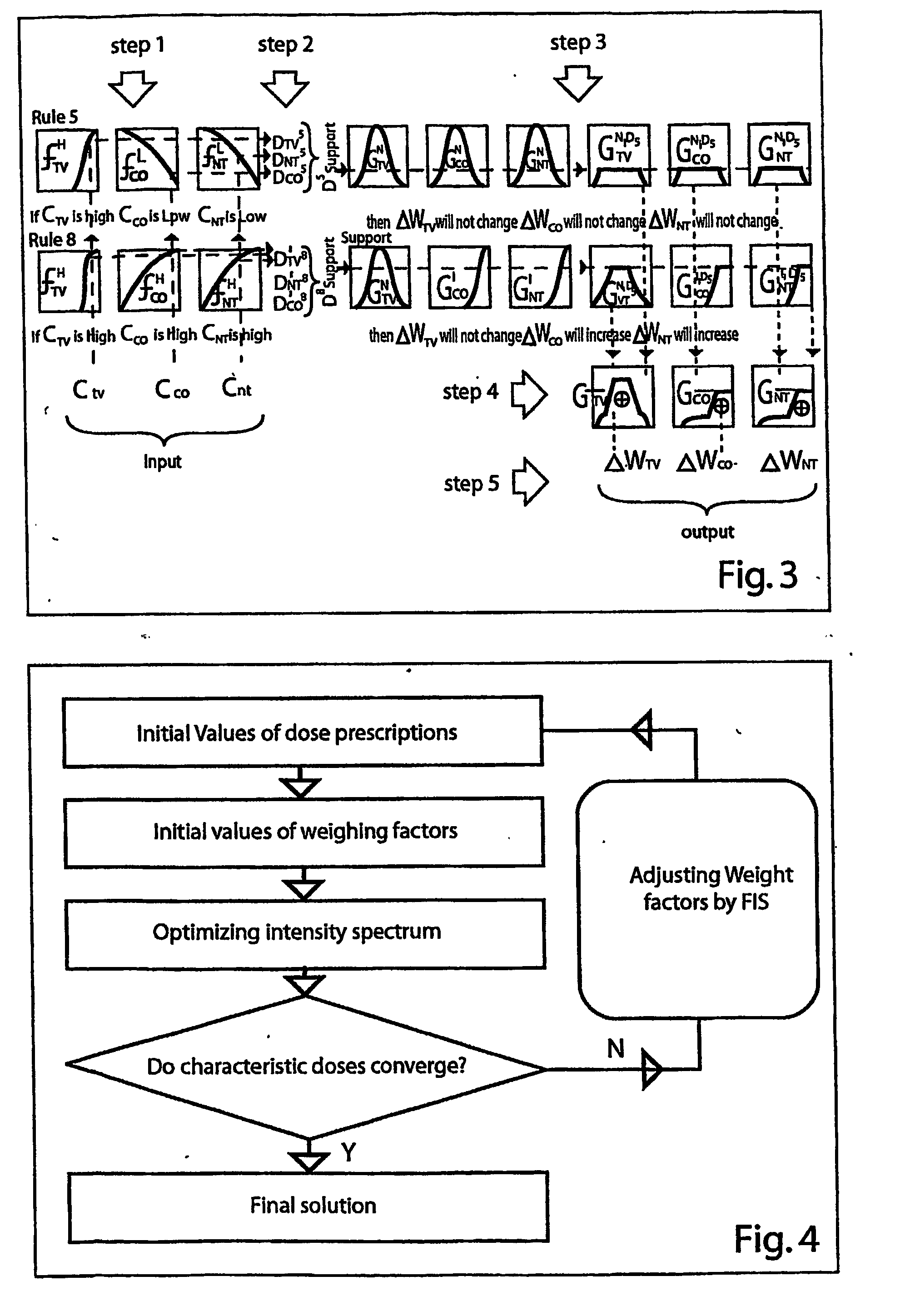Fuzzy logic guided inverse treatment planning
a technology of fuzzy logic and inverse treatment planning, applied in the field of artificial intelligence guiding inverse treatment planning, can solve the problems of significant patient liability, limited treatment success, and high cost of dedicated scanning beam therapy machines, and achieve the effects of improving the uniformity of target dose, improving treatment efficiency, and improving the control of dose for sensitive organs
- Summary
- Abstract
- Description
- Claims
- Application Information
AI Technical Summary
Benefits of technology
Problems solved by technology
Method used
Image
Examples
example 1
[0065] This is a simulated cylindroid object and its central slice is illustrated in FIG. 2. The geometry of this slice is similar to a CT head axial cut with two sensitive organs (analog to eyes) that are very close to the target volume. The prescription was given as follows: 100 dose units to the target volume, 20 dose units to the sensitive organs, and upper limit of 60 dose units to the normal tissue. Seven fan beams as shown in FIG. 2 were uniformly arranged between 0-2 π. Based on the primary-only model, the dose at depth is estimated by means of the percent depth dose data that were measured from a field size of 4×4 cm with 6MV photon beams. However, beam divergence was included.
[0066] In order to show the convergence and fastness of FMD method, the FMD algorithm was run using three different values of the step-length: λn=0.01, λn=λopt and λn=0.001 (n=1, 2, . . . , N). Here λopt is the optimal step-length. FIG. 3 shows the differences of convergence behavior between λn=λopt ...
example 2
[0071] The central slice of the phantom geometry in Example 2 is illustrated in FIG. 9. Similar to Example 1, seven fan beams are arranged at 0, 2 π / 7, 4 π / 7, 6 π / 7, 8 π / 7, 10 π / 7, and 12 π / 7, respectively. The prescribed doses were set: 100 dose units for the target volume, 20 dose units for the sensitive organs and the upper limit dose of 60 dose units for the normal tissue. The other parameters were L=100 and K=5.
[0072]FIG. 10 shows dose-volume histograms obtained by using FIIP, HIP(a) and HIP(b) methods for the example 2. FIG. 10(a) corresponds to the target volume, FIG. 10(b) to the sensitive organs, and FIG. 10(c) to the normal tissue. Table 3 indicates the relevant statistical parameters: means, standard deviations for the three structures in Example 2. The performance patterns of the FIP algorithm in Example 2 is consistent with the results obtained in Example 1. However, the optimal normal tissue value pn here is equal to 30. Note that in this example one can also obtain a...
example 3
Materials and Methods
[0113] For a given dose prescription, conventional inverse treatment planning consists of two steps: (1) finding the suitable weighting factors for involved organs and (2) optimizing the intensity spectrum based on the given weighting factors. As there are a large number of choices for weighting factors, finding the desired ones for a given objective function is difficult. The involved organs in this system are categorized as the target volume (TV), the critical organs (CO), and the normal tissue (NT).
The Principle of the Fuzzy Inference System
[0114] The flow chart of FIS is illustrated in FIG. 1. It consists of three main modules: the Fuzzifier, the Inference Engine (consisting of fuzzy rules) and the Defuzzifier. For each variable input to the fuzzy inference system, a number of fuzzy sets are defined with appropriate membership functions. These membership functions are labeled with linguistic tags frequently used by humans (such as “High” dose). During t...
PUM
 Login to View More
Login to View More Abstract
Description
Claims
Application Information
 Login to View More
Login to View More - R&D
- Intellectual Property
- Life Sciences
- Materials
- Tech Scout
- Unparalleled Data Quality
- Higher Quality Content
- 60% Fewer Hallucinations
Browse by: Latest US Patents, China's latest patents, Technical Efficacy Thesaurus, Application Domain, Technology Topic, Popular Technical Reports.
© 2025 PatSnap. All rights reserved.Legal|Privacy policy|Modern Slavery Act Transparency Statement|Sitemap|About US| Contact US: help@patsnap.com



